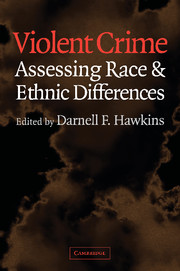Book contents
- Frontmatter
- Contents
- Contributors
- Foreword
- Editor's Introduction
- Violent Crime
- Part I Homicide Studies
- Part II Other Contexts, Settings, and Forms of Violence
- Part III Explaining Racial and Ethnic Differences
- 11 How Can the Relationship between Race and Violence be Explained?
- 12 “Race Effects” and Conceptual Ambiguity in Violence Research: Bringing Inequality Back In
- 13 The Violent Black Male: Conceptions of Race in Criminological Theories
- 14 The Structural-Cultural Perspective: A Theory of Black Male Violence
- 15 A Cultural Psychology Framework for the Study of African-American Morality and Violence
- 16 Racial Discrimination and Violence: A Longitudinal Perspective
- 17 Honor, Class, and White Southern Violence: A Historical Perspective
- References
- Index
14 - The Structural-Cultural Perspective: A Theory of Black Male Violence
Published online by Cambridge University Press: 22 August 2009
- Frontmatter
- Contents
- Contributors
- Foreword
- Editor's Introduction
- Violent Crime
- Part I Homicide Studies
- Part II Other Contexts, Settings, and Forms of Violence
- Part III Explaining Racial and Ethnic Differences
- 11 How Can the Relationship between Race and Violence be Explained?
- 12 “Race Effects” and Conceptual Ambiguity in Violence Research: Bringing Inequality Back In
- 13 The Violent Black Male: Conceptions of Race in Criminological Theories
- 14 The Structural-Cultural Perspective: A Theory of Black Male Violence
- 15 A Cultural Psychology Framework for the Study of African-American Morality and Violence
- 16 Racial Discrimination and Violence: A Longitudinal Perspective
- 17 Honor, Class, and White Southern Violence: A Historical Perspective
- References
- Index
Summary
Introduction
One of the most significant challenges confronting America is the disproportionately high rate of homicide and nonfatal violence occurring among black males. There exists very little consensus among criminologists and other crime scholars regarding “the causes” of black male violence. Numerous explanations have been offered, including acquired biological causes (e.g., head injuries) (Bell, 1987); social disorganization and inadequate socialization (Shaw and McKay, 1942); poverty and economic inequality (Blau and Blau, 1982); racial oppression and displaced aggression (Johnson, 1941; Poussaint, 1983); adherence to the norms of a subculture of violence (Wolfgang and Ferracuti, 1967); joblessness and family disruption (Sampson, 1987); the cheapening of black life as a result of the imposition of lenient sentences against blacks who assault or murder blacks (Hawkins, 1983); and involvement in self-destructive lifestyles centered around heavy drinking (Harper, 1976; Gary, 1986), drug abuse and drug trafficking (Goldstein et al., 1989), and street gangs (Block and Block, 1993; Decker and VanWinkle, 1996). Theoretical explanations of black male violence have generally emphasized the significance of structural factors (Staples, 1974; Hawkins, 1983) or cultural factors (Frazier, 1939; Wolfgang and Ferracuti, 1967).
Although they represent a minority viewpoint, some criminologists maintain that racial differences in violent crime offending may stem from genetic/nonacquired biological factors (Hirschi and Hindelang, 1977; Ellis and Walsh, 1997). For example, proponents of cheater theory suggest that there exists a population of men who possess genes that incline them toward extremely low parental involvement.
- Type
- Chapter
- Information
- Violent CrimeAssessing Race and Ethnic Differences, pp. 280 - 302Publisher: Cambridge University PressPrint publication year: 2003
- 11
- Cited by

